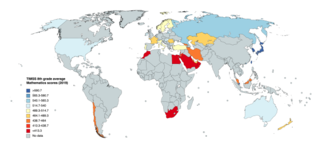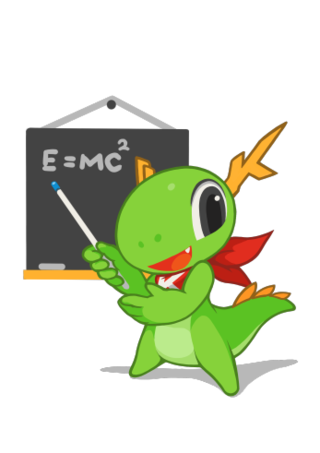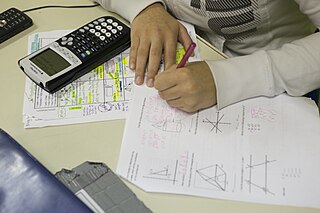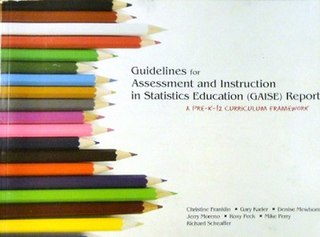
In contemporary education, mathematics education—known in Europe as the didactics or pedagogy of mathematics—is the practice of teaching, learning, and carrying out scholarly research into the transfer of mathematical knowledge.

A graphing calculator is a handheld computer that is capable of plotting graphs, solving simultaneous equations, and performing other tasks with variables. Most popular graphing calculators are programmable calculators, allowing the user to create customized programs, typically for scientific, engineering or education applications. They have large screens that display several lines of text and calculations.
In statistics, exploratory data analysis (EDA) is an approach of analyzing data sets to summarize their main characteristics, often using statistical graphics and other data visualization methods. A statistical model can be used or not, but primarily EDA is for seeing what the data can tell us beyond the formal modeling and thereby contrasts traditional hypothesis testing. Exploratory data analysis has been promoted by John Tukey since 1970 to encourage statisticians to explore the data, and possibly formulate hypotheses that could lead to new data collection and experiments. EDA is different from initial data analysis (IDA), which focuses more narrowly on checking assumptions required for model fitting and hypothesis testing, and handling missing values and making transformations of variables as needed. EDA encompasses IDA.
Principles and Standards for School Mathematics (PSSM) are guidelines produced by the National Council of Teachers of Mathematics (NCTM) in 2000, setting forth recommendations for mathematics educators. They form a national vision for preschool through twelfth grade mathematics education in the US and Canada. It is the primary model for standards-based mathematics.

RKWard is a transparent front-end to the R programming language, a scripting-language with a strong focus on statistics functions. RKWard tries to combine the power of the R language with the ease of use of commercial statistical packages.
Advanced Placement (AP) Statistics is a college-level high school statistics course offered in the United States through the College Board's Advanced Placement program. This course is equivalent to a one semester, non-calculus-based introductory college statistics course and is normally offered to sophomores, juniors and seniors in high school.

The IEA's Trends in International Mathematics and Science Study (TIMSS) is a series of international assessments of the mathematics and science knowledge of students around the world. The participating students come from a diverse set of educational systems in terms of economic development, geographical location, and population size. In each of the participating educational systems, a minimum of 4,000 to 5,000 students is evaluated. Contextual data about the conditions in which participating students learn mathematics and science are collected from the students and their teachers, their principals, and their parents via questionnaires.
Mathematics education in Australia varies significantly between states, especially at the upper secondary level. While every school offers a state-based education systems, some may also offer the International Baccalaureate program.

Core-Plus Mathematics is a high school mathematics program consisting of a four-year series of print and digital student textbooks and supporting materials for teachers, developed by the Core-Plus Mathematics Project (CPMP) at Western Michigan University, with funding from the National Science Foundation. Development of the program started in 1992. The first edition, entitled Contemporary Mathematics in Context: A Unified Approach, was completed in 1995. The third edition, entitled Core-Plus Mathematics: Contemporary Mathematics in Context, was published by McGraw-Hill Education in 2015.

The KDE Education Project develops free educational software based on the KDE technologies for students and parents. These educational software is translated into more than 65 languages, so that users can access them without any problems. The KDE-Edu project also provides free software educational to support and facilitate teachers in planning lessons.

Mathematics education in the United States varies considerably from one state to the next, and even within a single state. However, with the adoption of the Common Core Standards in most states and the District of Columbia beginning in 2010, mathematics content across the country has moved into closer agreement for each grade level. The SAT, a standardized university entrance exam, has been reformed to better reflect the contents of the Common Core. However, many students take alternatives to the traditional pathways, including accelerated tracks. As of 2023, twenty-seven states require students to pass three math courses before graduation from high school, while seventeen states and the District of Columbia require four. A typical sequence of secondary-school courses in mathematics reads: Pre-Algebra, Algebra I, Geometry, Algebra II, Pre-calculus, and Calculus or Statistics. However, some students enroll in integrated programs while many complete high school without passing Calculus or Statistics. At the other end, counselors at competitive public or private high schools usually encourage talented and ambitious students to take Calculus regardless of future plans in order to increase their chances of getting admitted to a prestigious university and their parents enroll them in enrichment programs in mathematics.
Statistics education is the practice of teaching and learning of statistics, along with the associated scholarly research.

The Concord Consortium was founded in 1994 as an educational research and development organization to create large-scale improvements in K-14 teaching and learning through technology.

The Guidelines for Assessment and Instruction in Statistics Education (GAISE) are a framework for statistics education in grades Pre-K–12 published by the American Statistical Association (ASA) in 2007. The foundations for this framework are the Principles and Standards for School Mathematics published by the National Council of Teachers of Mathematics (NCTM) in 2000. A second report focused on statistics education at the collegiate level, the GAISE College Report, was published in 2005. Both reports were endorsed by the ASA. Several grants awarded by the National Science Foundation explicitly reference the GAISE documents as influencing or guiding the projects, and several popular introductory statistics textbooks have cited the GAISE documents as informing their approach.
In statistics education, informal inferential reasoning refers to the process of making a generalization based on data (samples) about a wider universe (population/process) while taking into account uncertainty without using the formal statistical procedure or methods.
Bootstrap is based at Brown University (USA), and builds on the research and development done there. Bootstrap curriculum consists of 4 research-based curricular computer science modules for grades 6-12. The 4 modules are Bootstrap:Algebra, Bootstrap:Reactive, Bootstrap:Data Science, and Bootstrap:Physics. Bootstrap materials reinforce core concepts from mainstream subjects like Math, Physics and more, enabling non-CS teachers to adopt the introductory materials while delivering rigorous and engaging computing content drawn from Computer Science classes at universities like Brown, WPI, and Northeastern.

The Casio Algebra FX series was a line of graphing calculators manufactured by Casio Computer Co., Ltd from 1999 to 2003. They were the successor models to the CFX-9970G, the first Casio calculator with computer algebra system, or CAS, a program for symbolic manipulation of mathematical expressions. The calculators were discontinued and succeeded by the Casio ClassPad 300 in 2003.
Arthur Bakker is a Dutch mathematics education researcher and associate professor at the Freudenthal Institute, Utrecht University, Netherlands. He is Fellow at the University of Bremen.










